The Australian Government’s Gender Politics
By Natasha Grivas
According to the United Nations Women in Politics: 2015 list, Australia ranks 44th when it comes to the percentage of female members in the lower and upper houses of parliament.
The top ten countries like Rwanda, Cuba, Bolivia and South Africa attribute their ranking to the implementation of gender quotas, where increases of female involvement are a necessity of governments.
PhD student at the Australian National University’s school of Politics and International Relations Blair Williams says, normalising women in politics will eliminate the idea of government being a masculine space.
“Parliament has always been a masculine institution. Women have to work twice as hard to be seen as good as their male counterpart. But it becomes easier with more women entering the space. It becomes normalised,” Williams said.
With 25.7% of female members in the lower house and 38.2% in the Senate, the current state of Australian political parties and the use of gender quotas is on a voluntary basis.
Where parties can choose whether or not to adopt the quota.
According to figures found through the ABC’s Vote Compass, 56% of men disagreed on the adoption of these measures, with 22% of men agreeing. Compared to 49% of women who supported the use of gender quotas in parliament.
The Liberal party under former Prime Minister Tony Abbott had only one women in the cabinet, although the number of women in Malcolm Turnbull’s cabinet increased to five.
Blair Williams says implementing the gender quota is a positive idea because it would put pressure on government to increase the number of females in parliament.
“When people disagree with the quota, it’s quite ridiculous. Because they think women will get in even if they’re not competent and that’s assuming women aren’t competent,” Williams said.
“The quotas will really speed things up. If we’re going to wait for progress to happen, I think we’ll be waiting a while. Without putting pressure on them, they have no motivation to increase the number.”
“The quotas will give women the chance to shine and it’ll become more normalised. And when you normalise it, it’ll mean more women will feel safe to enter the space because they won’t experience such misogyny.”
As it stands in 2016, there are currently 40 women in the House of Representatives and 110 men. This is in comparison to the 2006 figures where there were 37 women, showing a slight 2% increase in female members.
“Women have always been othered,” Williams said. “And women are slowly infiltrating and slowly taking up that space. But when we do take up that space we are seen as deviants or not as competent.”
“You saw the treatment of Julia Gillard. She experienced horrible misogynistic treatment and I think that’s because the space she entered, a space of the prime ministerial role is extremely masculine and that no other woman has entered before,” she said.
Past statistics show a wide gap between the number of females to males in Australian government positions and although the gender quota could help minimise it, Blair Williams says it’s also about changing media and public perception.
“Ideally I would like the media to have restrictions on how they treat women. I think if the public puts pressure on the media to say something is sexist, eventually they might get a bit better.”
“The public has a part to play as well.”





